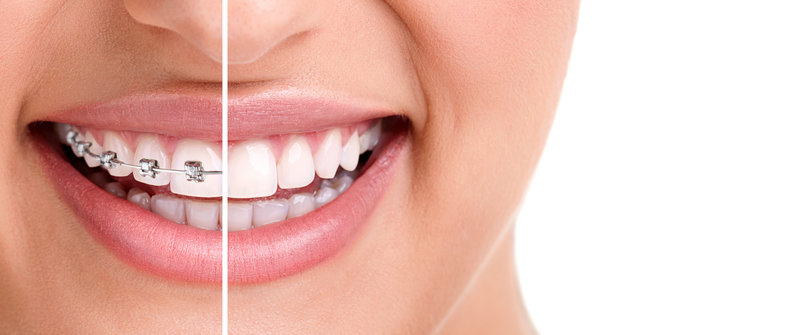Get Your Braces in Time for Back-to-School

Going back to school can be an exciting time whether you’re a child, teen or an adult. However, if you have recently had your braces put on or plan to get them before school starts, there are some things you should prepare for. Those include planning ahead so that you can clean your teeth at school, that you have food you can eat with braces and more. As you go back to school this year, use these tips for taking care of your braces and for showing them off to your peers!
Should You Get Braces?
Many people see braces and try to decide if they are right for them. Receiving orthodontic care does take time, but it’s time well spent. Most patients are generally wearing their orthodontic appliance for 18-24 months at a time. However, you can achieve a straight smile that will last you the rest of your life.
There are incredible benefits that come with getting braces, and we’re not just talking about getting straighter teeth. Braces can correct a patient’s problems with bite and alignment. These types of problems can create speech impediments over time and can make it difficult for patients to bite, chew, smile and more. Add crooked teeth on top of that, and the teeth also become much more difficult to clean. When they are more difficult to clean, patients generally miss cleaning areas that eventually decay. Without orthodontic treatment, you raise your risk for tooth decay and gum disease, as well as dental emergencies. Crooked teeth and bite problems can lead to broken and cracked teeth over time.
However, braces can get rid of all those risk factors that lead to chronic dental problems. And you don’t really have to do much except keep your braces clean! Studies also show that people who straighten their teeth tend to smile more, and they actually have a major confidence boost that stays with them. Going back-to-school is a great time to get that extra confident boost!

Choosing Which Braces You Want
In the past, patients only had one dental option. Today, you have at least four options. At your consultation, you can learn about and choose from these options:
- Traditional Metal Braces: The metal brackets and wires many people think of when they think “braces”. The metal brackets attach to the front of every tooth and are held in place by a metal wire that goes along the bottom and top teeth. The molars have metal bands that go all the way around the tooth in the back to keep the braces very sturdy.
- Ceramic Braces: These are designed just like traditional metal braces, but they are made from white, ceramic material to blend with the teeth. Even the wire can be made white for patients.
- Lingual Braces: With Incognito Lingual Braces, you can achieve the same results as traditional braces with a hidden treatment apparatus on the tongue-side of your teeth. These braces consist of metal that is custom-molded to fit on the back of all your teeth. The metal covers the entire back instead of simply consisting of a bracket. However, there is still a small bracket that holds the metal wire in place. The main advantage of lingual braces is that they can straighten and correct bite problems without being seen.
- Invisalign: This treatment consists of transparent aligners custom-made for a patient’s teeth that they switch out every week. Over time, crooked teeth become straight. The aligners can be removed for any activity (eating, brushing, sports), however, they can’t correct major bite issues.

Watch What You Eat
With any new thing, there is always a learning curve. Braces are no different. For the first few days, your mouth will have to adjust to having an orthodontic appliance attached to the teeth. The newness of your braces will fade, but the need to take care of them won’t fade. One of the main things you need to watch out for with braces is what you eat. Many students get lunch from the cafeteria, snack bars, or fast food places. If this is you, be careful what you eat and aim to avoid foods such as:
- Hard candies: These generally contain lots of sugar and chewing on them can break brackets and wires.
- Avoid hard foods such as nuts, chips, popcorn (because of kernels), apples, crusty bread, carrots or hard vegetables.
- Ice: Never chew ice, as this can break orthodontic appliances and can crack or break a tooth. Always suck on ice; never chew.
- Sticky Sugary Foods. These include caramels, taffy, licorice, Tootsie Rolls, Starburst, Sugar Daddies, Skittles and candies that are similar.
- Gum: This gets stuck in all your orthodontic appliances and most are sugary, meaning that stuck food will be able to sit on your teeth and eat away at your tooth enamel.
Nobody wants to get back-to-school and have a dental emergency happen. If you always watch what you eat, you don’t have to worry about dental emergencies and serious oral health issues.
Get Your Braces in Time for Back-to-School
Do you want to make an amazing transformation this year? Start with your smile! Your smile is one of the first things others notice. You want to make that smile shine. For the perfect smile you are envisioning, we can help make it a reality! Simply call Belmar Orthodontics today at (303) 225-9016 for your free consultation!
Before, After and During Braces

What do you need to know before, after and during braces? How do you prepare for orthodontic care? The American Dental Association says that patients can greatly benefit from both dental and orthodontic care if they want a better smile. Seeing a dentist often as a child can help you prepare for braces in the future. Seeing a dentist and orthodontist early on can also help prevent serious oral health issues. When preparing for braces, you will receive an oral exam, x-rays, and have molds of your teeth made. You may even need dental work done as well. We can help you know what you need to do before braces, during, and after braces to achieve a better smile!
Preparing for Braces
Seeing your dentist is the best way to prepare for braces. The ADA recommends that patients visit their dentist at least biannually (meaning twice a year). Patients who have gum disease or are prone to tooth decay (cavities) may need to visit their dentist more often than that to prevent problems. A dentist can detect abnormal bites or alignment in children. This early detection can help children to see an orthodontist early-on for care before bite and alignment problems become severe. Most patients see an orthodontist around the early adolescent years to straighten the teeth. This is because most alignment problems are apparent after the permanent teeth have come into the mouth.
Studies show that most patients who receive braces are between 8 and 14 years old. You will visit your dentist and then often see an orthodontist after. That orthodontist will do a full exam of your teeth including your jaws and mouth and how your bite and alignment are. X-rays help to determine the position of the teeth in the jaw and help an orthodontist plan how your teeth must move to come into correct alignment during your treatment. Much like a dental office, you will have molds (also called “impressions”) made for your teeth. A plaster model of your teeth will be made that the orthodontist can made a plan from. In preparing for braces, you should plan on between 18-24 months of wearing braces to receive a straight smile. However, know that braces can be fun and are an investment in your future.
Caring for Your Braces
Your braces will be a new experience for you. At first, you may have a tender mouth, as your teeth will have to get used to the new brackets that are on them. Brackets are the squares attached to each tooth. There will be an archwire that runs through each bracket and helps mold your jaw arch correctly. You may also have elastic rubber bands and steel bands in the back of your teeth that are attached to the tooth. You must take extra time each day to care for your braces properly. If you brushed for 2 minutes before braces, you will have to extend that time now. Each bracket can get food stuck in it with any given meal, so it’s important that you brush each tooth and especially brush the bracket at different angles to dislodge food that has become stuck.
Flossing is extra important as well, because it is usually a step that is skipped if patients are short on time. Flossing requires setting aside around 10 minutes of your time to do it right. Use a floss threader to thread the floss under your wire, then floss between your teeth like normal. You will have to thread the floss for each individual tooth, but the time is worth it as it helps to decrease your risk for tooth decay between the teeth. Some patients may need to use a proxy brush or toothpicks to dislodge foods from the brackets. A mouthrinse with fluoride can help keep the teeth healthy as well.
After Your Orthodontic Care
You’ve spent 18-24 months to get a better smile. Now what? It is highly important to wear your retainer every single day after your braces come off. Your teeth have been moved into place very recently and can even start changing back into their crooked paths in the first month after braces if the retainer is not worn. Wear your retainer according to what the orthodontist suggests. If you follow their recommendations for taking care of your smile, you can look forward to many decades of a better smile with beautiful teeth.
A smile is not complete once it is straight. You still must brush and floss the teeth every single day to prevent tooth decay and gum disease, both of which can destroy your smile. However, both of these are avoidable if you follow basic oral hygiene.
A Better Smile Today
If you care for your braces well, then you can expect to have a beautiful smile after your treatment is over. A better smile can bring you added confidence and success, which is what we want for every patient. If you are preparing for braces, follow our recommendations. You can even learn more about preparation, what to do with braces in special circumstances, and ask questions you may have after your care is over. Simply call our Belmar Orthodontics office at (303) 225-9016 to know more!

